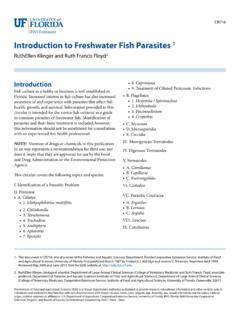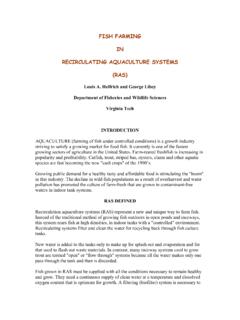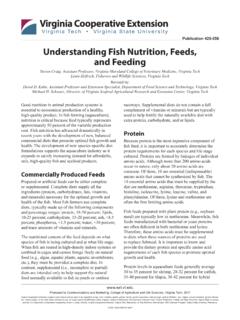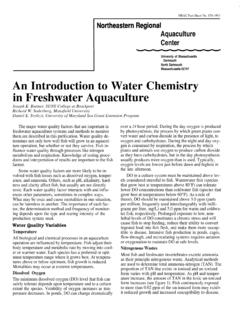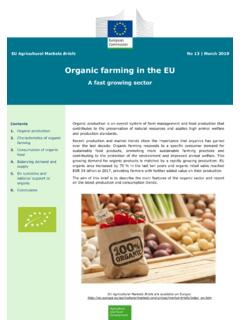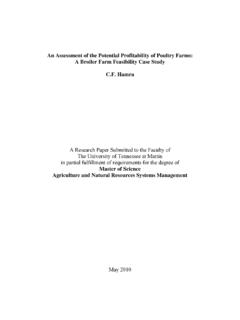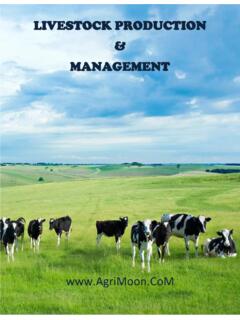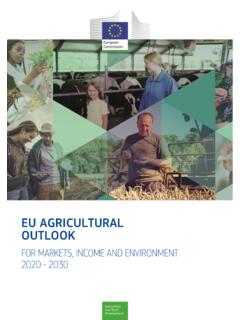Transcription of FISH FARMING IN RECIRCULATING AQUACULTURE …
1 fish FARMING . IN. RECIRCULATING AQUACULTURE SYSTEMS. (RAS). Louis A. Helfrich and George Libey Department of Fisheries and Wildlife Sciences Virginia Tech INTRODUCTION. AQUACULTURE ( FARMING of fish under controlled conditions) is a growth industry striving to satisfy a growing market for food fish . It currently is one of the fastest growing sectors of agriculture in the United States. Farm-reared freshfish is increasing in popularity and profitability. Catfish, trout, striped bas, oysters, clams and other aquatic species are fast becoming the new "cash crops" of the 1990's. Growing public demand for a healthy tasty and affordable food is stimulating the "boom". in this industry. The decline in wild fish populations as a result of overharvest and water pollution has promoted the culture of farm-fresh that are grown in contaminant-free waters in indoor tank systems.
2 RAS DEFINED. Recirculation AQUACULTURE systems (RAS) represent a new and unique way to farm fish . Instead of the traditional method of growing fish outdoors in open ponds and raceways, this system rears fish at high densities, in indoor tanks with a "controlled" environment. RECIRCULATING systems filter and clean the water for recycling back through fish culture tanks. New water is added to the tanks only to make up for splash out and evaporation and for that used to flush out waste materials. In contrast, many raceway systems used to grow trout are termed "open" or "flow through" systems because all the water makes only one pass through the tank and then is discarded. fish grown in RAS must be supplied with all the conditions necessary to remain healthy and grow. They need a continuous supply of clean water at a temperature and dissolved oxygen content that is optimum for growth.
3 A filtering (biofilter) system is necessary to purify the water and remove or detoxify harmful waste products and uneaten feed. The fish must be fed a nutritionally-complete feed on a daily basis to encourage fast growth and high survival. EXPERIMENTAL SYSTEM. RAS have been in existence, in one form or another, since the mid 1950's. However, only in the past few years has their potential to grow fish on a commercial-scale been realized. New water quality technology, testing and monitoring instrumentation, and computer- enhanced system design programs, much of it developed for the waste water treatment industry, have been incorporated and have revolutionized our ability to grow fish in tank culture. Nevertheless, despite its apparent potential, RAS should be considered a high-risk, experimental form of agriculture at this time.
4 They can be used to culture high-densities (over a million pounds) of fish annually, but their ability to do so economically remains to be demonstrated, conclusively and repeatedly. BENEFITS OF RAS. RAS offer fish producers a variety of important advantages over open pond culture. These include a method to maximize production on a limited supply of water and land, nearly complete environmental control to maximize fish growth year-round, the flexibility to locate production facilities near large markets, complete and convenient harvesting, and quick and effective disease control. RAS can be of various sizes ranging from large-scale production systems (over 1 million pounds per year) to intermediate-sized systems (500,000 pounds per year), to small systems (50,000 pounds per year). They can be used as grow-out systems to produce food fish or as hatcheries to produce eggs and fingerling sport fish for stocking and ornamental fish for home aquariums.
5 Intensive Production: RAS applies to the broiler house or swine barn concept, so prevalent and effectively used in modern poultry and pork production systems, to rear large numbers of fish in a relatively small space. Indoor fish FARMING in tanks may revolutionize fish production in the same way that confinement systems altered the pork and poultry FARMING industries. This is an excellent alternative to open pond culture where low densities (extensive culture) of fish are reared free in large ponds and are subject to losses from diseases, parasites, predation, pollutants, stress, and seasonally suboptimal growing conditions. Water and Land Conserved: RAS conserve both water and land. They maximize production in a relatively small area of land and use a relatively small volume of water. For example, using a RAS it is possible to product over 100,000 pounds of fish in a 5,000 square-foot building, whereas 20 acres of outdoor ponds would be necessary to produce an equal amount of fish with traditional open pond culture.
6 Similarly, since water is reused, the water volume requirements in RAS are only about 20% of what conventional open pond culture demands. They offer a promising solution to water use conflicts, water quality, and waste disposal. These concerns will continue to intensify in the future as water demand for a variety of uses escalates. Location Flexibility: RAS are particularly useful in areas where land and water are expensive and not readily available. They require relatively small amounts of land and water. They are most suitable in northern areas where a cold or cool climate can slow fish growth in outdoor systems and prevent year-round production. RAS provide growers who are geographically disadvantaged because of a relatively short growing season (less than 200. days) or extremely dry (desert) conditions, a competitive, profitable, year-round fish production system.
7 They can be located close to large markets (urban areas) and thereby reduce hauling distances and transportation costs. RAS can use municipal water supplies (dechlorination is necessary) and discharge waste into sanitary sewer systems. Nearly all species of food fish and sport fish that are commonly reared in ponds including catfish, tout, and striped bass can readily be grown in high densities when confined in tank systems. Species and Harvest Flexibility: RAS are currently being used to grow catfish, striped bass, tilapia, crawfish, blue crabs, oysters, mussels, and aquarium pets. Indoor fish culture systems offer considerable flexibility to (1) grow a wide diversity of fish species, (2) rear a number of different species simultaneously in the same tank (polyculture) or different tanks (monoculture), (3) raise a variety of different sizes of one or several species to another depending on market demand and price.
8 RAS afford growers the opportunity to manipulate production to meet demand throughout the year and to harvest at the most profitable times during the year. This flexibility in the selection of species and harvest time allows the grower to rapidly respond to a changing marketplace in order to maximize production and profitability. RAS permit the grower to competitively respond to market price and demand fluctuations by altering harvest rates and times and the species cultured. Tank culture systems are now being used to hold and purge (depurate) contaminated of off-flavor, pond reared catfish until they are acceptable for marketing. RAS do have some disadvantages when compared to open pond culture. They are relatively expensive systems to develop (building, tanks, plumbing, biofilters) and to operate (pumping, aerating, heating, lighting).
9 Moreover, they are complex systems and require skilled technical assistance to manage successfully. Constant supervision and skilled technical support are required to manage and maintain the relatively complex circulation, aeration, and biofilter systems, and to conduct water quality analysis. The danger of mechanical or electrical power failure and resulting fish loss is always a major concern when rearing fish in high densities in small water volumes. Operating at or near maximum carrying capacity requires fail-safes in the form of emergency alarms and backup power and pump systems. The business and biological risk factors are correspondingly high. Continuous vigilance and quick reaction times (15. minutes or less) are needed to avert total mortality. However, the higher risk factor, capital investment, and operating costs can be offset by continuous production, reduced stress, improved growth, and production of a superior product in the RAS.
10 THE RAS DESIGN. The functional parts of a RAS include a: (1) growing tank, (2) sump of particulate removal device, (3) biofilter, (4) oxygen injection with U-tube aeration and, (5) water circulation pump. Depending on the water temperature and fish species selected, a water heating system may be necessary. Ozone and ultraviolet sterilization also may be advantageous to reduce organic and bacteria loads. Water Supply: A good supply of water, adequate in both quantity and quality, is essential to a successful fish FARMING enterprise, RAS or otherwise. Ground water obtained from deep wells or springs is the best source of water for fish culture. It generally is free of pollutants and has relatively high hardness levels, which are beneficial under some circumstances. Municipal water supplies also can be used after chlorine, floride, and other chemicals are removed.
